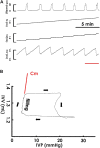Solifenacin/Mirabegron Induces an Acute Compliance Increase in the Filling Phase of the Capacity-Reduced Urinary Bladder: A Pressure-Volume Analysis in Rats
- PMID: 34122078
- PMCID: PMC8188241
- DOI: 10.3389/fphar.2021.657959
Solifenacin/Mirabegron Induces an Acute Compliance Increase in the Filling Phase of the Capacity-Reduced Urinary Bladder: A Pressure-Volume Analysis in Rats
Abstract
Aims: Pressure in the bladder, which is a high compliance organ, is only slightly elevated to a considerable filling volume during storage. Although cystometry off-line offers mean compliance, no protocol is available for real-time assays of the dynamics of bladder compliance, and the potential impact of solifenacin and mirabegron on dynamic bladder compliance has not been established. Methods: Along with constantly infused cystometry, a pressure-volume analysis (PVA) was performed by plotting intra-vesical volume against pressure in Sprague-Dawley rats. The instant compliance was assayed as the slope of the trajectory, and the mean compliance (Cm) was determined by the slope of the line produced by regression of the data points at the end of the first, second, and third quarters of the filling phase. Results: Under a steady-state, the PVA trajectory moved clockwise which shaped coincident enclosed loops with stable compliance. Though administering to naïve animals solifenacin, but not mirabegron (both 1 × 10-5-1 × 10-1 mg/kg, i.a.) decreased the peak pressure, both of these reagents exhibited acute increments in the trajectory slope and Cm of the filling phase in a dose-dependent manner (ED50 = 1.4 × 10-4 and 2.2 × 10-5 mg/kg, respectively). Resembling urine frequency/urgency in OAB patients, the voiding frequency of a capacity-reduced bladder was increased in association with decreased compliance which was ameliorated by both acute solifenacin and mirabegron injections (both 1 × 10-1 mg/kg). Conclusion: In addition to their well-known anti-inotropic/relaxative effects, solifenacin, and mirabegron induce an acute increase in bladder compliance to ameliorate OAB-like syndromes. Together with time-domain cystometry, PVA offers a platform for investigating the physiology/pathophysiology/pharmacology of bladder compliance which is crucial for urine storage.
Keywords: compliance; mirabegron; pressure-volume curve; solifenacin; urinary bladdder.
Copyright © 2021 Peng, Lai, Hsieh and Lin.
Conflict of interest statement
The authors declare that the research was conducted in the absence of any commercial or financial relationships that could be construed as a potential conflict of interest.
Figures






References
-
- Cardozo L., Lisec M., Millard R., van Vierssen Trip O., Kuzmin I., Drogendijk T. E., et al. (2004). Randomized, Double-Blind Placebo Controlled Trial of the once Daily Antimuscarinic Agent Solifenacin Succinate in Patients with Overactive Bladder. J. Urol. 172 (5 Pt 1), 1919–1924. 10.1097/01.ju.0000140729.07840.16 - DOI - PubMed
-
- Chapple C. R., Cruz F., Cardozo L., Staskin D., Herschorn S., Choudhury N., et al. (2020). Safety and Efficacy of Mirabegron: Analysis of a Large Integrated Clinical Trial Database of Patients with Overactive Bladder Receiving Mirabegron, Antimuscarinics, or Placebo. Eur. Urol. 77 (1), 119–128. 10.1016/j.eururo.2019.09.024 - DOI - PubMed
LinkOut - more resources
Full Text Sources
Miscellaneous

